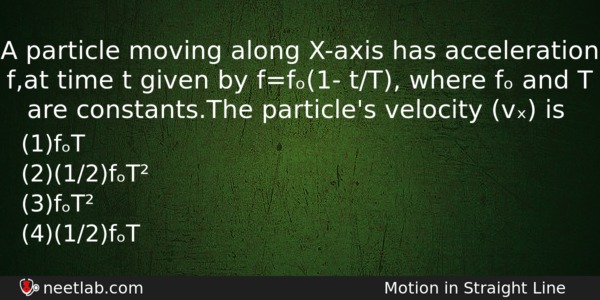| ⇦ | 
| ⇨ |
A particle moving along X-axis has acceleration f,at time t given by f=fₒ(1- t/T), where fₒ and T are constants. The particle’s velocity (vₓ) is
Options
(a) fₒT
(b) (1/2)fₒT²
(c) fₒT²
(d) (1/2)fₒT
Correct Answer:
(1/2)fₒT
Explanation:
Acceleration, f = dv/dt = f₀[1-(t/T)]
dv = f₀[1-(t/T)]dt —–(i)
On integrating Equation (i) both sides, we get
.·. v = f₀t – (f₀/T)(t²/2)dt + C —–(ii)
After applying boundery conditions v = 0 at t = 0, we get
Therefore, C = 0
v = f₀t – (f₀/T)(t²/2)dt —–(iii)
As, f = f₀[1-(t/T)]
When, f = 0,t = T
Substituting, t = T in Equation (iii), then velocity
vₓ = f₀T – (f₀/T)(T²/2)
= f₀T – (1/2)f₀T = (1/2)fₒT
Related Questions: - A block of mass m is placed on a smooth wedge of inclination θ
- For an ideal gas of diatomic molecules
- The moon’s radius is 1/ 4 that of the earth and its mass is 1 / 80 times that of the earth
- The displacement of particle is given by x=aₒ+(a₁t/2)-(a₂t²/3) what is acceleration?
- If a given volume of water in a 220V heater is boiled in 5 min, then same volume
Topics: Motion in Straight Line
(93)
Subject: Physics
(2479)
Important MCQs Based on Medical Entrance Examinations To Improve Your NEET Score
- A block of mass m is placed on a smooth wedge of inclination θ
- For an ideal gas of diatomic molecules
- The moon’s radius is 1/ 4 that of the earth and its mass is 1 / 80 times that of the earth
- The displacement of particle is given by x=aₒ+(a₁t/2)-(a₂t²/3) what is acceleration?
- If a given volume of water in a 220V heater is boiled in 5 min, then same volume
Topics: Motion in Straight Line (93)
Subject: Physics (2479)
Important MCQs Based on Medical Entrance Examinations To Improve Your NEET Score
18000+ students are using NEETLab to improve their score. What about you?
Solve Previous Year MCQs, Mock Tests, Topicwise Practice Tests, Identify Weak Topics, Formula Flash cards and much more is available in NEETLab Android App to improve your NEET score.
Share this page with your friends

Leave a Reply